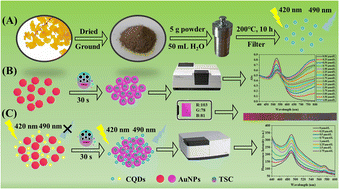Construction of a three-mode sensor based on gold nanoparticles and carbon quantum dots as probes for the detection of thiosemicarbazone†
Abstract
In this study, ginkgo leaves were used as a carbon source to synthesize carbon quantum dots (CQDs) with uniform particle size, high fluorescence (FL) intensity and strong stability, using a hydrothermal method. FL could be quenched by the FL resonance energy transfer effect between CQDs and gold nanoparticles (AuNPs), an important FL quenching agent. The electrostatic attraction between thiosemicarbazone (TSC) and citrate on the surface of AuNPs and the formation of a stable Au–S bond between TSC and AuNPs led to the aggregation of AuNPs and thus weakened the quenching effect on CQDs and partly recovered the FL. A sensor in FL mode for the detection of TSC was constructed based on the above-mentioned FL “off” and “on” phenomena. The results showed a good linear correlation in the concentration range 0–1.75 μM, and the limit of detection was as low as 0.05 μM. In addition, the aggregation of AuNPs caused by TSC also led to a change in the absorbance curve and color of the solution; colorimetric and chrominance detection modes were also constructed using these two types of changes, with sensitive responses ranging 0–2.25 μM and 0–1.60 μM and the limits of detection of 0.03 μM and 0.08 μM, respectively. More importantly, these three detection modes obtained satisfactory recovery rates in the detection of the TSC content in river water, liquor and wheat samples, and the detection results were mutually verified (95.18% to 104.96%).



 Please wait while we load your content...
Please wait while we load your content...